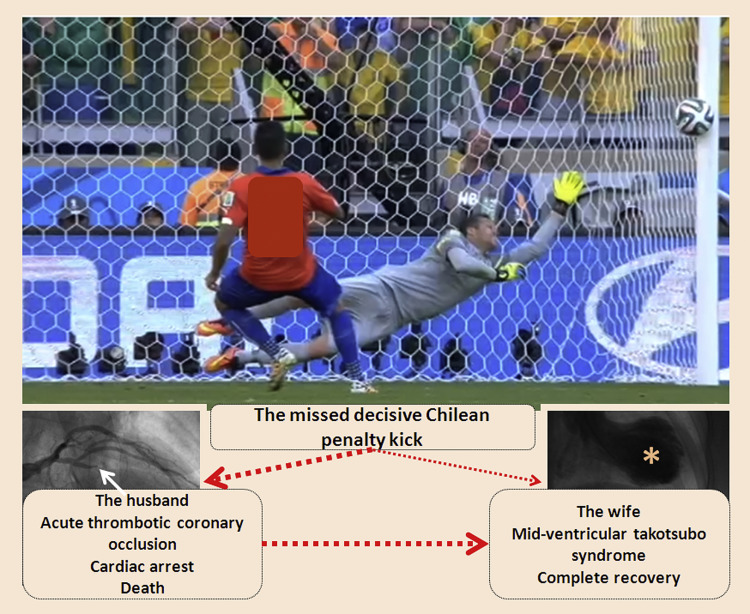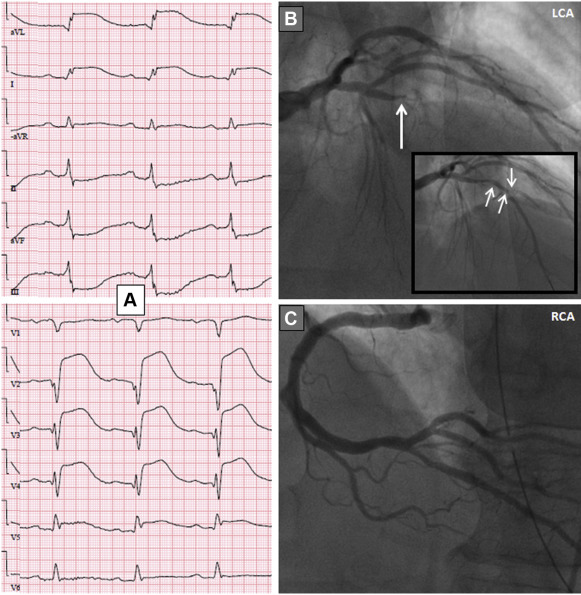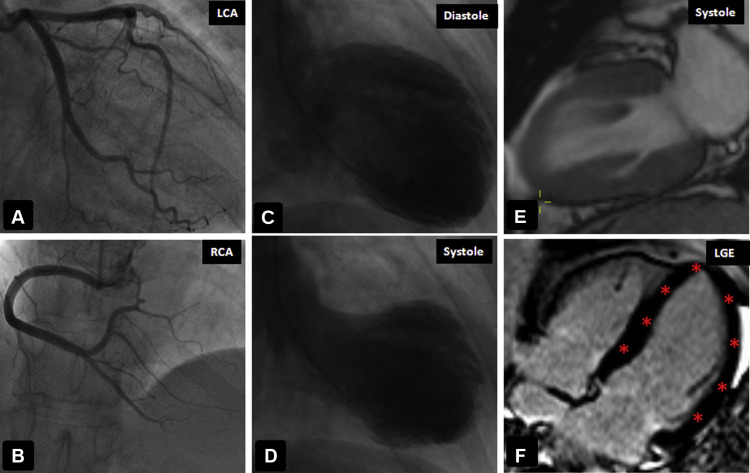Events that induce emotional stress and frustration in a large number of subjects under specific circumstances, such as earthquakes, war conditions, and sporting occasions, may increase the incidence of cardiovascular events, such as acute myocardial infarction, arrhythmias, and sudden cardiac death. This report describes a married couple who expressed an apparently passionate interest in football with hazardous consequences after a tense football match during the FIFA 2014 World Championships. A series of emotional stressors initiated by defeat in this football game lead to cardiac arrest in a 58-year-old man caused by a thrombotic occlusion of the left anterior descending artery and ending in the death of the patient. An hour and 15 minutes after the onset of cardiac arrest of the patient, his 64-year-old wife also had chest pain caused by an acute midventricular takotsubo syndrome. She survived the acute stage of the disease, and there was complete resolution of the left ventricular dysfunction.
Events that induce emotional stress and frustration in a large number of subjects under specific circumstances, such as earthquakes, war conditions, and sporting occasions, may increase the incidence of acute cardiovascular events. To our knowledge, only 1 case of takotsubo syndrome (TS) triggered by an acute emotional stress event caused by the defeat of his favorite soccer team during the Euro 2012 cup has been described. Here, we describe 2 tragic cases where a series of emotional stressors initiated by a defeat in a football game lead to cardiac arrest in a man ending in coronary death and acute TS in his wife.
Case Presentations
A married couple of Chilean origin, together with their 3 offspring watched the dramatic Brazil versus Chile, knockout phase football match on Saturday, June 28, 2014. With intense involvement, the family had to wait and watch up to the last second of a long match where the last and the deciding Chilean penalty kick clanked off the left goalpost ( Figure 1 ) sending Brazil to the next round, whereas Chile headed home in defeat. This dramatic Chilean defeat was followed by a fierce quarrel involving the whole family and triggering acute chest pain of ischemic character in the 58-year-old father of the family. Two hours later, he had a cardiac arrest. After 20 minutes of cardiopulmonary resuscitation and 2 defibrillations for ventricular fibrillation, the patient regained a spontaneous circulation. On arrival at the emergency room, the electrocardiogram showed extensive anterolateral ST-segment elevation and reciprocal inferior ST-segment depression ( Figure 2 ). The patient was unconscious and in a state of cardiogenic shock with a systolic blood pressure of 75 mm Hg. Emergency invasive coronary angiography revealed a proximal left anterior descending (LAD) artery occlusion ( Figure 2 , large white arrow ) and atheromatous changes in the left circumflex and right coronary arteries ( Figure 2 ). After recanalization, the LAD revealed signs of acute plaque rupture and thrombosis involving the LAD/diagonal bifurcation region ( Figure 2 , in miniature with small arrows ). The LAD was stented, and the diagonal branch was successfully recanalized by balloon angioplasty. After the procedure, the patient was transferred to the intensive care unit. Despite 72 hours of intensive life support including a period of induced hypothermia to targeted temperature of 36 C, he remained in an unconscious state. A computed tomography scan of the brain and repeated neurologic examinations were consistent with extensive and irreversible anoxic brain damage, eventually leading to the death of the patient 3 days after admission.


An hour and 15 minutes after the onset of cardiac arrest of our patient, his 64-year-old wife also had acute chest pain, which lasted approximately 30 minutes. An electrocardiogram showed mild inferolateral ST-segment elevation, and a high-sensitive troponin T was mildly elevated at 349 ng/L. Emergency invasive coronary angiography, performed within an hour of her husband entering the same laboratory, showed atheromatous changes in a segment of LAD with a suspicion of myocardial bridging but without systolic compression; the left circumflex and the right coronary arteries were normal ( Figure 3 ). Fractional flow reserve in the LAD was normal. Left ventriculography showed marked hypokinesia in the middle part of the left ventricle with preserved apical and basal myocardial contractility resulting in conspicuous midventricular ballooning ( Figure 3 ). The left midventricular ballooning was confirmed by cardiac magnetic resonance imaging, which in addition showed no late gadolinium enhancement ( Figure 3 ). These findings are consistent with TS. Serial transthoracic echocardiographic examinations showed improvement and normalization of left ventricular function during the hospital stay. The patient consented to the publication of her TS episode and that of her husband’s coronary death.





